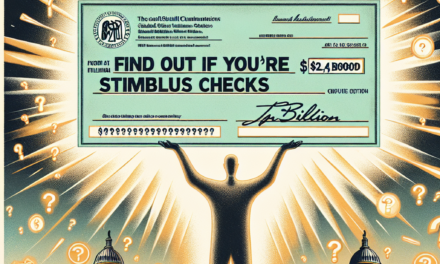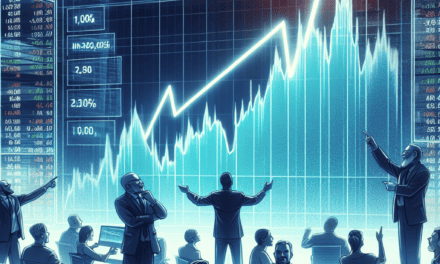“Market Cools as Powell Signals Patience on Rate Cuts”
Introduction
In the wake of Federal Reserve Chair Jerome Powell’s recent remarks, financial markets have reacted with a notable decline in futures. Powell’s indication that there is no immediate rush to implement rate cuts has tempered investor optimism, leading to a recalibration of market expectations. His comments suggest a cautious approach to monetary policy, emphasizing the need for sustained economic stability before considering any reduction in interest rates. This stance has prompted a reassessment among traders and investors, who had been anticipating potential easing measures in response to evolving economic conditions. As a result, futures have experienced a downturn, reflecting the market’s adjustment to the Fed’s current policy outlook.
Impact Of Powell’s Statement On Global Markets
Federal Reserve Chair Jerome Powell’s recent remarks have sent ripples through global financial markets, as he indicated that there is no immediate rush to cut interest rates. This statement has led to a decline in futures, reflecting investor sentiment and the broader implications for economic policy. Powell’s cautious stance underscores the Federal Reserve’s commitment to maintaining a balanced approach to monetary policy, prioritizing economic stability over rapid adjustments. As a result, market participants are recalibrating their expectations, leading to a notable impact on global markets.
In the wake of Powell’s comments, futures markets experienced a downturn, as investors reassessed their strategies in light of the Federal Reserve’s apparent reluctance to ease monetary policy. This decline in futures is indicative of broader market apprehensions, as traders and investors grapple with the implications of sustained higher interest rates. The Federal Reserve’s cautious approach suggests that it is closely monitoring economic indicators, such as inflation and employment, before making any significant policy shifts. Consequently, this has led to increased volatility in financial markets, as participants adjust to the prospect of a prolonged period of elevated rates.
Moreover, Powell’s statement has had a ripple effect on global markets, influencing central banks and financial institutions worldwide. Many central banks look to the Federal Reserve as a benchmark for their own monetary policies, and Powell’s indication of no immediate rate cuts may prompt other central banks to adopt a similar stance. This could lead to a tightening of global financial conditions, as countries align their policies with the Federal Reserve’s cautious approach. As a result, emerging markets, which are often sensitive to changes in U.S. monetary policy, may face additional challenges, including capital outflows and currency depreciation.
Furthermore, the impact of Powell’s remarks extends beyond financial markets, affecting various sectors of the global economy. For instance, businesses that rely on borrowing may face higher financing costs, potentially leading to reduced investment and slower economic growth. Additionally, consumers may experience increased borrowing costs for mortgages and other loans, which could dampen consumer spending and further impact economic activity. These factors highlight the interconnectedness of global markets and the far-reaching consequences of the Federal Reserve’s policy decisions.
In light of these developments, investors and market participants are closely monitoring upcoming economic data releases and Federal Reserve communications for further insights into the central bank’s policy trajectory. The anticipation of future rate decisions is likely to continue influencing market dynamics, as participants seek to navigate the evolving economic landscape. While Powell’s statement has introduced a degree of uncertainty, it also reinforces the importance of data-driven decision-making in shaping monetary policy.
In conclusion, Jerome Powell’s indication of no rush for rate cuts has had a significant impact on global markets, leading to a decline in futures and influencing central banks worldwide. The Federal Reserve’s cautious approach underscores its commitment to economic stability, prompting market participants to adjust their expectations accordingly. As the global economy continues to navigate these challenges, the interplay between monetary policy and market dynamics remains a critical area of focus for investors and policymakers alike. The ongoing assessment of economic indicators will be crucial in determining the future direction of interest rates and their broader implications for global financial markets.
Analyzing The Federal Reserve’s Stance On Interest Rates
In recent developments, futures markets have experienced a decline following Federal Reserve Chair Jerome Powell’s remarks, which suggested that there is no immediate urgency to reduce interest rates. This statement has significant implications for investors and the broader economy, as it provides insight into the Federal Reserve’s current stance on monetary policy. Understanding the nuances of Powell’s comments is crucial for stakeholders who are trying to navigate the complexities of the financial landscape.
To begin with, Powell’s indication that rate cuts are not imminent reflects the Federal Reserve’s cautious approach to managing economic growth and inflation. The central bank has been grappling with the dual mandate of fostering maximum employment while maintaining price stability. In recent months, inflationary pressures have been a primary concern, with consumer prices rising at rates not seen in decades. Consequently, the Federal Reserve has been employing a series of interest rate hikes to temper inflation and prevent the economy from overheating.
However, Powell’s recent comments suggest a shift in focus. While the central bank remains vigilant about inflation, there is a growing recognition of the need to balance this with the potential risks of stifling economic growth. By signaling that rate cuts are not on the immediate horizon, Powell is emphasizing the importance of a measured approach. This stance is likely intended to reassure markets that the Federal Reserve is committed to a stable economic environment, even as it navigates the challenges posed by fluctuating economic indicators.
Moreover, Powell’s remarks come at a time when global economic conditions are increasingly uncertain. Geopolitical tensions, supply chain disruptions, and varying recovery rates from the pandemic have all contributed to a complex economic backdrop. In this context, the Federal Reserve’s cautious approach can be seen as an effort to maintain flexibility in its policy toolkit. By not committing to immediate rate cuts, the central bank retains the ability to respond dynamically to unforeseen economic developments.
The impact of Powell’s comments on futures markets underscores the sensitivity of financial markets to signals from the Federal Reserve. Investors closely monitor such statements for clues about the future direction of monetary policy, as these can have profound effects on asset prices and investment strategies. The decline in futures following Powell’s remarks suggests that market participants may have been anticipating a more dovish stance, perhaps hoping for signals of forthcoming rate cuts to stimulate economic activity.
In conclusion, Jerome Powell’s indication that there is no rush to cut interest rates highlights the Federal Reserve’s commitment to a balanced approach in its monetary policy. While inflation remains a concern, the central bank is also mindful of the broader economic landscape and the need to support sustainable growth. As investors and policymakers continue to interpret these signals, the Federal Reserve’s stance will remain a critical factor in shaping economic expectations and financial market dynamics. Ultimately, Powell’s comments serve as a reminder of the intricate balancing act that central banks must perform in guiding economies through periods of uncertainty and change.
Investor Reactions To Delayed Rate Cuts
In the wake of Federal Reserve Chair Jerome Powell’s recent remarks, futures markets have experienced a notable decline, reflecting investor reactions to the prospect of delayed interest rate cuts. Powell’s indication that the Federal Reserve is in no hurry to reduce rates has sent ripples through financial markets, prompting investors to reassess their strategies and expectations. This development underscores the intricate relationship between central bank policies and market dynamics, highlighting the sensitivity of investors to monetary policy signals.
Powell’s comments came during a closely watched speech, where he emphasized the need for a cautious approach to monetary policy adjustments. He pointed out that while inflation has shown signs of moderating, it remains above the Federal Reserve’s target. Consequently, the central bank is committed to maintaining a restrictive stance until there is more concrete evidence of sustained progress toward its inflation goals. This cautious tone has led to a recalibration of market expectations, as investors had previously anticipated a more imminent shift toward rate cuts.
The immediate reaction in futures markets was a decline, as traders adjusted their positions in light of the revised outlook. The prospect of prolonged higher interest rates has implications for various asset classes, particularly equities and bonds. Higher rates tend to increase borrowing costs for companies, potentially dampening corporate profits and, by extension, stock prices. Additionally, the bond market is affected as yields adjust to reflect the anticipated path of monetary policy, impacting fixed-income investments.
Moreover, the delayed rate cuts have broader implications for the global economy. Many economies are closely linked to U.S. monetary policy, and the Federal Reserve’s decisions often influence central banks worldwide. A prolonged period of higher rates in the United States could lead to tighter financial conditions globally, affecting emerging markets and economies with significant dollar-denominated debt. This interconnectedness underscores the importance of Powell’s statements and their far-reaching impact.
Investors, therefore, find themselves navigating a complex landscape, balancing the potential risks and rewards associated with the Federal Reserve’s policy trajectory. Some market participants may view the delay in rate cuts as a prudent measure to ensure economic stability and prevent a resurgence of inflation. Others, however, may express concerns about the potential for slower economic growth and the challenges posed by sustained higher borrowing costs.
In response to these developments, investors are likely to adopt a more cautious approach, seeking to diversify their portfolios and hedge against potential volatility. This may involve a shift toward defensive sectors, such as utilities and consumer staples, which tend to be less sensitive to economic cycles. Additionally, there may be increased interest in alternative investments, such as commodities or real estate, as investors seek to mitigate the impact of interest rate fluctuations.
In conclusion, the decline in futures following Powell’s indication of no rush for rate cuts highlights the intricate interplay between central bank policies and investor sentiment. As the Federal Reserve maintains its cautious stance, market participants are compelled to reassess their strategies and adapt to a potentially prolonged period of higher interest rates. This evolving landscape underscores the importance of staying informed and agile in navigating the complexities of today’s financial markets.
Economic Implications Of Sustained High Interest Rates

In recent developments, futures markets have experienced a notable decline following Federal Reserve Chair Jerome Powell’s indication that there is no immediate rush to cut interest rates. This announcement has significant implications for the economy, as it suggests that the current high interest rate environment may persist longer than previously anticipated. Understanding the economic implications of sustained high interest rates is crucial for investors, businesses, and policymakers alike.
To begin with, high interest rates typically lead to increased borrowing costs for both consumers and businesses. When interest rates remain elevated, individuals may find it more expensive to finance large purchases such as homes and cars. This can lead to a decrease in consumer spending, which is a critical driver of economic growth. As consumer spending slows, businesses may experience reduced revenues, potentially leading to cutbacks in investment and hiring. Consequently, the broader economy may face slower growth, which can have ripple effects across various sectors.
Moreover, businesses that rely heavily on borrowing to finance their operations or expansion plans may find themselves particularly vulnerable in a high interest rate environment. Higher borrowing costs can squeeze profit margins, making it more challenging for companies to maintain their competitiveness. This situation can be especially pronounced for small and medium-sized enterprises, which often have less access to capital markets compared to larger corporations. As a result, sustained high interest rates can stifle innovation and entrepreneurship, further dampening economic dynamism.
In addition to affecting consumer behavior and business operations, high interest rates can also have significant implications for the housing market. As mortgage rates rise, potential homebuyers may be deterred from entering the market, leading to a slowdown in housing demand. This can result in a cooling of home prices, which may impact homeowners’ equity and overall wealth. Furthermore, a sluggish housing market can have downstream effects on related industries, such as construction and real estate services, potentially leading to job losses and reduced economic activity in these sectors.
On the other hand, it is important to recognize that sustained high interest rates can also have some positive effects on the economy. For instance, higher rates can encourage savings, as individuals and institutions may be more inclined to deposit money in interest-bearing accounts. This can lead to an increase in the availability of capital for investment, which can be beneficial for long-term economic growth. Additionally, higher interest rates can help contain inflationary pressures by curbing excessive borrowing and spending, thereby promoting price stability.
Nevertheless, the balance between these positive and negative effects is delicate, and the Federal Reserve’s cautious approach to rate cuts reflects the complexity of managing economic growth while maintaining financial stability. As futures markets react to Powell’s statements, it is clear that investors are recalibrating their expectations for the near-term economic outlook. This recalibration underscores the importance of clear communication from central banks, as market participants seek to navigate the uncertainties associated with monetary policy decisions.
In conclusion, the decline in futures following Powell’s indication of no rush for rate cuts highlights the broader economic implications of sustained high interest rates. While there are potential benefits, such as increased savings and inflation control, the challenges posed by higher borrowing costs and reduced consumer spending cannot be overlooked. As the economy continues to adapt to this environment, stakeholders must remain vigilant and responsive to the evolving landscape, ensuring that policies and strategies are aligned with the goal of fostering sustainable economic growth.
Strategies For Investors Amidst Uncertain Rate Cuts
In the wake of Federal Reserve Chair Jerome Powell’s recent remarks, futures markets have experienced a notable decline, reflecting investor sentiment that interest rate cuts may not be imminent. This development has prompted a reevaluation of strategies among investors who are navigating the complexities of an uncertain economic landscape. As Powell indicated a cautious approach to adjusting rates, it becomes imperative for investors to reassess their portfolios and consider strategies that can withstand potential volatility.
To begin with, understanding the implications of Powell’s stance is crucial. The Federal Reserve’s decision to maintain current interest rates suggests a focus on stabilizing inflation and ensuring economic growth. This cautious approach, while prudent, signals to investors that the era of easy money may not return as swiftly as some had hoped. Consequently, investors must adapt by seeking opportunities that align with a potentially prolonged period of higher interest rates.
One strategy that investors might consider is diversifying their portfolios to include assets that traditionally perform well in a high-interest-rate environment. For instance, sectors such as financials and energy often benefit from rising rates. Financial institutions, including banks and insurance companies, can experience improved profit margins as they capitalize on the spread between lending rates and deposit rates. Similarly, energy companies may see increased revenues as commodity prices adjust to the economic climate.
Moreover, investors should also contemplate the role of fixed-income securities in their portfolios. While rising interest rates can negatively impact bond prices, they also present opportunities for those willing to adjust their strategies. Short-duration bonds or floating-rate notes can offer more resilience against rate hikes, providing a buffer against potential losses. Additionally, investors might explore inflation-protected securities, which can help preserve purchasing power in an environment where inflation remains a concern.
In addition to sector-specific strategies, investors should also focus on maintaining a long-term perspective. Market fluctuations, driven by interest rate expectations, can lead to short-term volatility. However, a disciplined approach that emphasizes long-term goals can help investors weather these fluctuations. By maintaining a diversified portfolio and adhering to a well-defined investment plan, investors can mitigate the impact of short-term market movements.
Furthermore, it is essential for investors to stay informed about economic indicators and central bank communications. Powell’s remarks underscore the importance of understanding the broader economic context in which investment decisions are made. By keeping abreast of developments in monetary policy and economic data, investors can make more informed decisions and adjust their strategies accordingly.
In conclusion, the decline in futures following Powell’s indication of no rush for rate cuts serves as a reminder of the complexities inherent in today’s financial markets. Investors must navigate this environment with a strategic mindset, focusing on diversification, sector-specific opportunities, and a long-term perspective. By doing so, they can position themselves to not only withstand potential volatility but also capitalize on opportunities that arise amidst uncertainty. As the economic landscape continues to evolve, staying informed and adaptable will be key to achieving investment success.
Historical Context: Federal Reserve’s Rate Decisions
The Federal Reserve’s decisions on interest rates have long been a focal point for investors, economists, and policymakers alike, given their profound impact on the economy. Historically, the Federal Reserve, often referred to simply as the Fed, has used interest rate adjustments as a primary tool to either stimulate economic growth or curb inflation. The delicate balance of these decisions can influence everything from consumer spending to business investments, and ultimately, the overall health of the economy. In recent years, the Fed’s approach to interest rates has been closely scrutinized, particularly in the wake of economic disruptions caused by global events and domestic challenges.
In the past, the Fed has often been quick to lower interest rates during periods of economic downturn to encourage borrowing and spending. Conversely, during times of rapid economic growth and rising inflation, the Fed has typically raised rates to prevent the economy from overheating. This cyclical approach has been a hallmark of the Fed’s strategy, aiming to maintain economic stability and foster sustainable growth. However, the economic landscape has evolved, and with it, the Fed’s approach to rate adjustments has also seen shifts.
Recently, Federal Reserve Chair Jerome Powell’s remarks have signaled a departure from the traditional urgency associated with rate cuts. Powell’s indication that there is no rush to reduce rates has led to a decline in futures, reflecting market participants’ recalibration of expectations. This cautious stance can be attributed to several factors, including the current economic conditions and the Fed’s broader objectives. By not rushing into rate cuts, the Fed appears to be prioritizing a more measured approach, allowing for a comprehensive assessment of economic indicators before making any significant policy shifts.
The decision to hold off on immediate rate cuts can be seen as a reflection of the Fed’s commitment to data-driven decision-making. In an era where economic signals can be mixed and sometimes contradictory, the Fed’s reliance on a wide array of data points ensures that its policies are well-informed and balanced. This approach also underscores the Fed’s awareness of the potential long-term implications of its actions, particularly in a global economy that is increasingly interconnected.
Moreover, Powell’s stance highlights the Fed’s focus on maintaining credibility and managing expectations. By clearly communicating its intentions and rationale, the Fed aims to provide stability and predictability to markets, which can help mitigate volatility. This transparency is crucial, as it allows businesses and consumers to make informed decisions based on a clearer understanding of the economic landscape.
In conclusion, the historical context of the Federal Reserve’s rate decisions provides valuable insights into the current approach under Chair Jerome Powell. By signaling no immediate rush for rate cuts, the Fed is emphasizing a cautious and data-driven strategy that prioritizes long-term economic stability over short-term market reactions. This approach not only reflects the complexities of the modern economic environment but also reinforces the Fed’s role as a steward of economic policy, committed to fostering sustainable growth and stability. As the economic landscape continues to evolve, the Fed’s decisions will undoubtedly remain a critical factor in shaping the future trajectory of the economy.
Future Projections: When Will Rate Cuts Occur?
In recent developments, futures markets have experienced a notable decline following Federal Reserve Chair Jerome Powell’s remarks, which suggested that there is no immediate urgency to implement rate cuts. This statement has sent ripples through financial markets, as investors recalibrate their expectations regarding the timeline for potential monetary policy easing. Powell’s comments underscore the Federal Reserve’s cautious approach in navigating the complex economic landscape, where inflationary pressures and economic growth prospects remain in a delicate balance.
The anticipation of rate cuts has been a focal point for investors, who have been closely monitoring economic indicators and central bank communications for any signs of a shift in monetary policy. However, Powell’s indication that the Federal Reserve is not in a hurry to reduce interest rates suggests a more measured approach, prioritizing the stabilization of inflation and ensuring sustainable economic growth. This stance reflects the central bank’s commitment to its dual mandate of promoting maximum employment and maintaining price stability.
In light of Powell’s remarks, market participants are now reassessing their projections for when rate cuts might occur. The Federal Reserve’s decision-making process is inherently data-dependent, meaning that future rate adjustments will be contingent upon evolving economic conditions. As such, investors are likely to pay close attention to upcoming economic data releases, including employment figures, inflation rates, and GDP growth, to gauge the potential trajectory of monetary policy.
Moreover, Powell’s comments highlight the importance of managing inflation expectations, which have been a persistent concern for policymakers. By signaling a cautious approach to rate cuts, the Federal Reserve aims to anchor inflation expectations and prevent them from becoming unmoored. This strategy is crucial in maintaining the credibility of the central bank and ensuring that inflation remains within target ranges over the medium term.
While the prospect of delayed rate cuts may initially disappoint some market participants, it is essential to recognize the broader context in which these decisions are made. The Federal Reserve’s cautious stance reflects a prudent approach to safeguarding the economy against potential risks, such as overheating or financial instability. By maintaining a steady hand on the monetary policy tiller, the central bank seeks to foster an environment conducive to sustainable economic growth.
Furthermore, Powell’s remarks serve as a reminder of the inherent uncertainties in economic forecasting. The global economy is subject to a myriad of factors, including geopolitical tensions, supply chain disruptions, and shifts in consumer behavior, all of which can influence the timing and magnitude of future rate adjustments. Consequently, investors and policymakers alike must remain vigilant and adaptable in the face of evolving economic dynamics.
In conclusion, the decline in futures following Powell’s indication of no rush for rate cuts underscores the complex interplay between monetary policy and market expectations. While the timing of future rate cuts remains uncertain, the Federal Reserve’s cautious approach reflects a commitment to balancing inflation control with economic growth objectives. As investors navigate this landscape, they will continue to scrutinize economic data and central bank communications for insights into the future trajectory of interest rates. Ultimately, the path to rate cuts will be shaped by a confluence of economic indicators and the Federal Reserve’s ongoing assessment of the macroeconomic environment.
Q&A
1. **What are futures?**
Futures are financial contracts obligating the buyer to purchase, or the seller to sell, an asset at a predetermined future date and price.
2. **Who is Powell?**
Jerome Powell is the Chair of the Federal Reserve, the central banking system of the United States.
3. **What did Powell indicate about rate cuts?**
Powell indicated that there is no rush to implement rate cuts, suggesting a cautious approach to changing interest rates.
4. **How do Powell’s comments affect futures?**
Powell’s comments can lead to a decline in futures as investors adjust their expectations for interest rates, impacting market sentiment and pricing.
5. **Why would futures decline after Powell’s statement?**
Futures might decline because investors may have anticipated rate cuts to stimulate economic growth, and Powell’s indication of no rush for cuts could dampen those expectations.
6. **What is the relationship between interest rates and futures?**
Interest rates influence borrowing costs and economic activity, affecting corporate profits and market conditions, which in turn impact futures prices.
7. **What sectors might be most affected by Powell’s comments?**
Interest rate-sensitive sectors such as real estate, financials, and consumer discretionary might be most affected by Powell’s comments on rate cuts.
Conclusion
The decline in futures following Federal Reserve Chair Jerome Powell’s indication of no immediate rush to cut interest rates reflects investor concerns about prolonged higher borrowing costs. Powell’s stance suggests a continued focus on controlling inflation, which may lead to tighter financial conditions and impact economic growth. This cautious approach by the Fed could result in market volatility as investors adjust their expectations for future monetary policy, potentially affecting investment strategies and economic forecasts.





